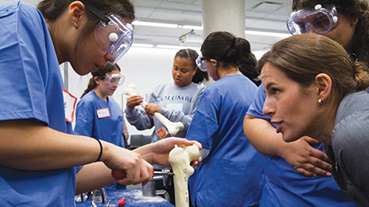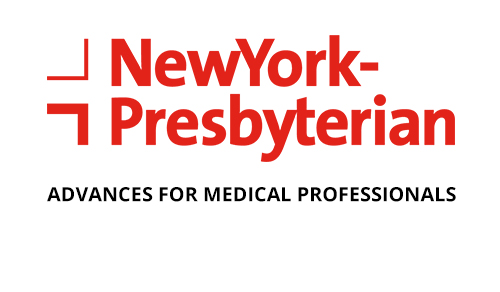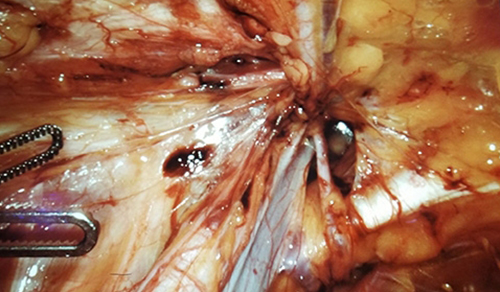Center for Athletic Hip Injuries and Hip Preservation: Addressing Hip Pain in Young Adults

Dr. T. Sean Lynch
While hip pain is a more common condition in older adults, in recent years it has been shown that younger athletic adults are also prone to hip problems that were once considered merely groin or muscle injuries. “In the last 10 to 15 years we’ve been able to improve our understanding of athletic hip pain with more advanced imaging, such as MRI and ultrasound, that allows us to get a more refined look into the hip joint to recognize subtle findings that can cause pain,” says T. Sean Lynch, MD, Director of the new Center for Athletic Hip Injuries and Hip Preservation in the Department of Orthopedic Surgery at NewYork-Presbyterian/
Dr. Lynch, who specializes in the nonoperative and operative treatment of hip and knee disorders in athletes of all levels, notes the Center brings together specialists, including a nonoperative sports medicine team, physiatrists, physical therapists, musculoskeletal radiologists, as well as open and arthroscopic hip surgeons, who are focused on providing joint-preserving treatment for young, active adults.
“Our goal is to maximize our non-surgical care through rest and anti-inflammatories, physical therapy, or physical therapy with an injection, so we can identify the source of the patient’s pain, but also try to help them recover without surgery.”
— Dr. T. Sean Lynch
“These patients are typically complex and having colleagues who can provide different areas of expertise and different insights is paramount to determining the diagnosis and planning treatment,” says Dr. Lynch. “I’ve treated a number of older athletes who have hips that are physiologically 20 years younger than what they are, and then I’ve seen patients who have hips that are 20 years older than their biological age. So, the first thing we assess is whether this is an arthritis problem or are we dealing with a young adult athletic hip injury more in the form of labral tears than the femoroacetabular impingement.”
“We see a spectrum of conditions, but predominantly it is femoroacetabular impingement, otherwise known as FAI, in which abnormal bone is present around the hip joint placing increased stresses on the cartilage and labrum,” continues Dr. Lynch. “We typically start our management utilizing the least invasive options, including rest, activity modification, and physical therapy to build up the patient’s core, lower back, and hip. We can also offer intra-articular injections of either cortisone or platelet-rich plasma to alleviate symptoms.”
The increasing prevalence of FAI in the adolescent population is due to several reasons, notes Dr. Lynch. “We have kids in their teenage and adolescent years playing a lot of sports and putting major stress on their hips, particularly on the growth plate on the femoral neck,” he explains. “The body’s natural reaction is to lay some bone next to it to help offload the area, and once the patient stops growing, they are left with that bump. The hip joint is supposed to be a round peg sitting into a round hole, but with hip impingement, it becomes a square peg trying to fit into a round hole, placing abnormal stress onto the labrum and the cartilage that leads to the tears that cause pain.”

A repaired labrum
In some cases, he says, the pain causes individuals to modify their walk so that they’re not taking as long of a walking stride. “They can also have pain with just normal daily activities — putting on their socks and shoes, sitting in class, and going up and down stairs. And obviously the pain causes some limitations of their sporting activities.”
“The hip is a complex area,” continues Dr. Lynch. “These conditions are typically not straightforward where, for example, with an injured ACL, rotator cuff, or meniscus, you can pick up on the diagnosis easily through the patient’s history and physical exam. With the hip, you have to tease through a lot of information, not only what the patient’s limitations are or where their pain is, but also how it is affecting them.”
“If a patient has dealt with this pain for a while, they can have soft tissue compensating issues, such as developing tight muscles in their back, knee pain, as well as pelvic floor pain,” says Dr. Lynch. “There are different layers of complexity — they may have a labral tear or possibly a sports hernia. Our goal is to maximize our non-surgical care through rest and anti-inflammatories, physical therapy, or physical therapy with an injection, so we can identify the source of the patient’s pain, but also try to to help them recover without surgery.”
Patients who have not been successful with nonoperative treatment approaches may require minimally invasive hip arthroscopy or an open hip preservation procedure, such as periacetabular osteotomy or a proximal femoral osteotomy. “With the arrival of Dr. Jakub Tatka [see page 4], an orthopedic surgeon who specializes in complex adult hip and knee reconstruction and hip preservation, we can offer patients the full range of surgical treatment options,” says Dr. Lynch.
“When patients come to us, we want to make sure they understand that our number one goal is to get them better by applying the least invasive methods possible,” adds Dr. Lynch. “However, for patients who require surgical intervention, hip arthroscopy is a great option to shave this extra bone off the femur and acetabulum while repairing the labrum. It is our hope that by treating this group of younger adults and addressing these issues earlier, we will be able to decrease the chance for their needing a hip replacement down the line.”
Developing Best Practice Guidelines for Hip Arthroscopy

Treatment algorithms for the arthroscopic management of femoroacetabular impingement remain debated due to a paucity of evidence-based guidance, and thus there is significant variability in clinical practice among practitioners. To address this, Dr. T. Sean Lynch led 15 hip arthroscopists from 14 institutions across the country to formally develop the first national consensus-based Best Practices Guidelines in Hip Arthroscopy driven by meta-analysis and a systematic literature review by a panel of experts.
“We utilized a Delphi approach, a way of helping to gather consensus on topics where the literature or the research is still lacking,” says Dr. Lynch. “We wanted to put together a safety checklist for providers who either might not be seeing a lot of these conditions or who are just starting off in their practice.”
The guidelines, which include 27 preoperative recommendations, 15 intraoperative practices, and 10 postoperative protocols, provide standardization of nonoperative and surgical management of FAI. As evidence becomes available, Dr. Lynch and the team will update the guidelines accordingly.
Reference Article
Best Practice Guidelines for Hip Arthroscopy in Femoroacetabular Impingement. Dr. T. Sean Lynch. ISHA Annual Scientific Meeting. October 4, 2018.
Related Publications

The Perry Initiative: Encouraging Young Women to Enter Orthopedics








